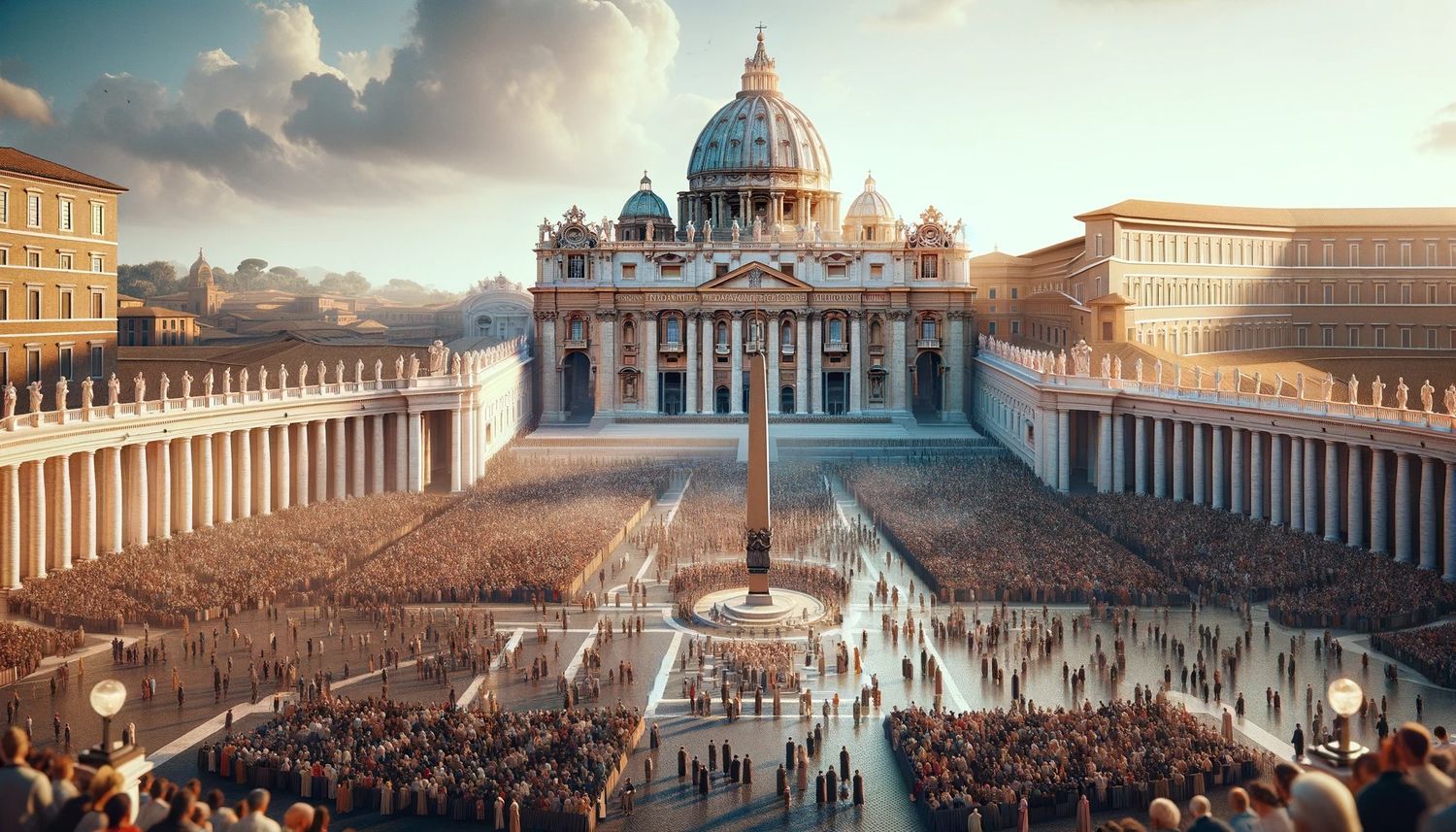Home>Theology and Spirituality>What Is The Symbol Of Catholicism


Theology and Spirituality
What Is The Symbol Of Catholicism
Published: February 18, 2024
Peter Smith, Editorial Director at Christian.net, combines deep insights into faith, politics, and culture to lead content creation that resonates widely. Awarded for his contributions to religious discourse, he previously headed a major organization for religious communicators, enhancing dialogue on faith's societal impacts.
Discover the significance of the symbol of Catholicism in theology and spirituality. Explore its rich history and cultural impact.
(Many of the links in this article redirect to a specific reviewed product. Your purchase of these products through affiliate links helps to generate commission for Christian.net, at no extra cost. Learn more)
Table of Contents
Introduction
Catholicism, with its rich history and profound symbolism, encompasses a myriad of visual representations that hold deep spiritual significance for its followers. These symbols serve as powerful reminders of key aspects of the faith, offering believers a tangible connection to the core tenets of Catholic theology and spirituality. From the iconic cross to the symbolic imagery of the Sacred Heart, each emblem carries a weight of tradition and meaning that has endured through centuries of religious practice.
In this article, we will delve into the diverse symbols of Catholicism, exploring their origins, interpretations, and enduring relevance in the lives of Catholics around the world. Each symbol encapsulates a unique facet of the faith, providing a visual language through which believers can express their devotion and draw inspiration for their spiritual journey. As we embark on this exploration, we will uncover the profound significance of these symbols and gain a deeper understanding of their role in the Catholic tradition.
Read more: What Is The Symbol Of Holy Communion
The Cross
The cross stands as the most universally recognized symbol of Catholicism, embodying the central tenets of the faith. Its significance stems from its association with the crucifixion of Jesus Christ, serving as a poignant reminder of his ultimate sacrifice for humanity's salvation. The vertical beam represents the divine, reaching from earth to heaven, while the horizontal beam symbolizes the earthly realm and the intersection of the divine with the material world.
In Catholic theology, the cross holds profound meaning, signifying redemption, forgiveness, and the triumph of love over sin and death. It serves as a visual representation of the core Christian belief in the crucifixion and resurrection of Jesus, encapsulating the hope and salvation offered through his sacrifice. The act of venerating the cross during religious ceremonies, such as the Good Friday liturgy, underscores its central role in Catholic worship and devotion.
Beyond its theological significance, the cross also serves as a personal emblem for individual Catholics, often worn as a pendant or displayed in homes and places of worship. This tangible symbol serves as a constant reminder of Christ's enduring love and the moral imperative for believers to take up their own crosses in the pursuit of righteousness and compassion.
The cross manifests in various forms within Catholic iconography, including the Latin cross, the Greek cross, and the crucifix. While the Latin cross features a longer vertical beam, the crucifix incorporates a representation of the body of Christ, emphasizing the intimate connection between Jesus' sacrifice and the symbol itself. This distinction underscores the centrality of Christ's suffering and resurrection in Catholic faith and underscores the profound impact of the crucifixion on the spiritual consciousness of believers.
In essence, the cross stands as a potent symbol of hope, redemption, and unwavering love within the Catholic tradition. Its enduring presence in religious art, devotional objects, and sacred spaces underscores its timeless significance as a visual testament to the heart of the Christian faith.
The Crucifix
The crucifix, a potent symbol within Catholicism, holds profound significance as a visual representation of the crucifixion of Jesus Christ. Unlike the plain cross, the crucifix features a depiction of the body of Christ, serving as a poignant reminder of his ultimate sacrifice for humanity's salvation. This iconic emblem encapsulates the heart of Catholic theology, embodying the central narrative of Christ's crucifixion and resurrection.
The image of Christ on the crucifix serves as a powerful focal point for Catholic devotion, evoking deep emotions and spiritual contemplation. It stands as a tangible manifestation of Christ's suffering and unwavering love, inviting believers to reflect on the profound implications of his sacrifice. The presence of the crucifix in Catholic homes, churches, and religious artifacts underscores its central role in shaping the spiritual consciousness of believers.
In addition to its theological significance, the crucifix also serves as a potent symbol of empathy and solidarity with human suffering. By depicting Christ's agony on the cross, it resonates with the universal experience of pain and adversity, offering solace and hope to those facing their own trials. The crucifix thus becomes a source of comfort and inspiration, reminding believers of Christ's redemptive love and the promise of spiritual renewal.
Throughout Catholic history, the crucifix has been a focal point of religious art, serving as a powerful visual narrative of Christ's sacrifice. From intricately carved wooden crucifixes to exquisitely crafted metal renditions, the diversity of artistic representations underscores the enduring impact of this symbol on the collective imagination of Catholic culture.
Moreover, the act of venerating the crucifix holds deep ritualistic significance within Catholic worship. Whether through personal prayer or communal liturgical practices, the faithful are called to contemplate the profound mystery of Christ's sacrifice as embodied in the crucifix. This contemplative engagement fosters a sense of spiritual intimacy and reverence, deepening the connection between believers and the core narrative of their faith.
In essence, the crucifix stands as a timeless symbol of redemption, compassion, and spiritual solidarity within the Catholic tradition. Its enduring presence in religious art, devotional objects, and sacred spaces underscores its profound impact on the spiritual consciousness of believers, inviting them to embrace the transformative power of Christ's sacrifice.
The Fish
The symbol of the fish, known as the Ichthys or Ichthus, holds a special place in the iconography of Catholicism, carrying profound historical and spiritual significance. Originating in the early Christian era, the fish symbol served as a covert sign of identification for followers of Jesus during times of persecution. Its discreet yet powerful symbolism allowed believers to recognize one another and express their faith without fear of reprisal.
The fish symbol derives its significance from the Greek word "Ichthys," which translates to "fish." However, it also serves as an acronym for the phrase "Iēsous Christos, Theou Yios, Sōtēr," meaning "Jesus Christ, Son of God, Savior" in Greek. This dual meaning imbues the fish symbol with layers of theological depth, encapsulating the core identity of Jesus and his redemptive mission.
In Catholic tradition, the fish symbolizes various aspects of faith, including Christ's call to his disciples to become "fishers of men," as recounted in the Gospels. This metaphorical imagery underscores the transformative power of the Christian message, inviting believers to spread the teachings of Christ and draw others into the embrace of divine grace.
Furthermore, the fish symbolizes abundance and sustenance, reflecting the miraculous multiplication of loaves and fishes by Jesus as a sign of his divine authority and provision. This motif of nourishment and spiritual abundance resonates deeply within Catholic theology, emphasizing the profound sustenance offered through communion with Christ and the sacramental life of the Church.
The fish symbol also serves as a visual representation of baptism, a central sacrament in Catholicism. As a creature of the water, the fish evokes the cleansing and rebirth experienced in the sacrament of baptism, symbolizing the believer's immersion into the life of Christ and emergence as a new creation.
Throughout Catholic art and iconography, the fish symbol appears in various forms, from intricately adorned depictions in religious paintings to subtle motifs in sacred architecture. Its enduring presence in religious imagery underscores its timeless relevance as a visual emblem of Christian identity and spiritual nourishment.
In essence, the fish stands as a potent symbol of Christian identity, mission, and spiritual sustenance within the Catholic tradition. Its multifaceted symbolism continues to inspire believers, inviting them to embrace the transformative power of Christ's message and participate in the abundant life offered through faith.
The Dove
The symbol of the dove holds a place of profound significance within the rich tapestry of Catholic symbolism, embodying themes of peace, purity, and the presence of the Holy Spirit. Throughout the history of Christianity, the dove has emerged as a potent emblem, carrying deep spiritual resonance and serving as a visual representation of divine grace and transcendence.
In Catholic theology, the dove is closely associated with the presence of the Holy Spirit, symbolizing the Spirit's role as a source of comfort, guidance, and inspiration for believers. This association finds its roots in the biblical narrative of Jesus' baptism, where the Holy Spirit descended upon him in the form of a dove, affirming his divine mission and inaugurating his public ministry. This pivotal event underscores the dove's significance as a symbol of divine anointing and the transformative power of the Spirit in the life of the faithful.
Moreover, the dove embodies the timeless aspiration for peace and reconciliation, reflecting the universal longing for harmony and goodwill. Its gentle and graceful presence evokes a sense of serenity and hope, offering a poignant reminder of the Christian call to be peacemakers and ambassadors of reconciliation in a world marked by strife and division.
In Catholic art and iconography, the dove often appears in depictions of the Annunciation and Pentecost, serving as a visual motif of the Spirit's transformative presence in the lives of Mary and the apostles. Whether portrayed in sacred paintings, stained glass windows, or liturgical vestments, the dove stands as a timeless symbol of spiritual renewal and the enduring legacy of God's grace within the Christian tradition.
Furthermore, the dove symbolizes purity and innocence, reflecting the scriptural imagery of the dove as a creature of gentleness and harmlessness. This motif resonates deeply within Catholic spirituality, inviting believers to cultivate a spirit of simplicity, humility, and moral integrity in their pursuit of holiness and spiritual growth.
In essence, the dove stands as a potent symbol of the Holy Spirit's presence, peace, and purity within the Catholic tradition. Its enduring significance continues to inspire believers, inviting them to embrace the transformative power of divine grace and embody the virtues of peace and spiritual renewal in their lives.
Read more: What Are Symbols Of Lent
The Lamb
The symbol of the lamb holds profound significance within the rich tapestry of Catholic symbolism, evoking themes of innocence, sacrifice, and redemption. Throughout the history of Christianity, the image of the lamb has emerged as a potent emblem, carrying deep spiritual resonance and serving as a visual representation of Christ's sacrificial atonement and the believer's call to emulate the virtues of meekness and purity.
In Catholic theology, the lamb is closely associated with the redemptive mission of Jesus Christ, often referred to as the "Lamb of God" in scripture. This title underscores Christ's role as the ultimate sacrificial offering, whose innocent suffering and death serve as the means of reconciling humanity with God. The imagery of the Paschal Lamb, as depicted in the Old Testament Passover and the Eucharistic liturgy, further emphasizes the lamb's significance as a symbol of deliverance, protection, and spiritual nourishment for the faithful.
Moreover, the lamb embodies the virtues of gentleness, humility, and purity, serving as a model of innocence and obedience. This motif resonates deeply within Catholic spirituality, inviting believers to cultivate a spirit of simplicity, meekness, and moral integrity in their pursuit of holiness and spiritual growth. The lamb's gentle and unassuming nature stands as a poignant reminder of Christ's call to his followers to embrace childlike faith and embody the qualities of compassion and selflessness in their interactions with others.
In Catholic art and iconography, the image of the lamb often appears in depictions of the Agnus Dei (Lamb of God), serving as a visual motif of Christ's sacrificial love and the believer's participation in the paschal mystery. Whether portrayed in sacred paintings, liturgical vestments, or devotional objects, the lamb stands as a timeless symbol of spiritual innocence, redemptive sacrifice, and the enduring legacy of Christ's atoning love within the Christian tradition.
In essence, the lamb stands as a potent symbol of Christ's sacrificial love, innocence, and spiritual purity within the Catholic tradition. Its enduring significance continues to inspire believers, inviting them to embrace the transformative power of Christ's redemptive sacrifice and embody the virtues of meekness and moral integrity in their lives.
The Keys of St. Peter
The symbol of the keys of St. Peter holds profound significance within the Catholic tradition, serving as a visual representation of the authority and stewardship entrusted to the apostle Peter by Jesus Christ. This iconic emblem, often depicted as a pair of crossed keys, embodies the spiritual authority and leadership vested in Peter as the foundational figure of the Church.
In the Gospel of Matthew, Jesus addresses Peter, saying, "I will give you the keys of the kingdom of heaven; whatever you bind on earth will be bound in heaven, and whatever you loose on earth will be loosed in heaven." This symbolic gesture signifies Peter's role as the custodian of the teachings of Christ, entrusted with the authority to guide and govern the early Christian community.
The imagery of the keys underscores Peter's pivotal role as the "rock" upon which the Church is built, as articulated in Jesus' proclamation, "You are Peter, and on this rock I will build my church." This declaration signifies Peter's foundational position within the ecclesiastical structure, symbolizing his role as the primary steward of the faith and the authoritative figure responsible for shepherding the Christian community.
In Catholic theology, the keys of St. Peter represent the continuity of apostolic succession and the unbroken lineage of spiritual authority passed down through the papacy. The papal insignia, featuring the crossed keys, serves as a visual reminder of the enduring legacy of Peter's leadership and the unifying role of the papacy in preserving the doctrinal integrity and spiritual unity of the Church.
Moreover, the keys symbolize the power of binding and loosing, signifying the authority to make authoritative decisions and declarations in matters of faith and morals. This spiritual prerogative underscores the role of the papacy in safeguarding the integrity of Christian doctrine and guiding the faithful in matters of ethical discernment and spiritual governance.
Throughout Catholic art and iconography, the keys of St. Peter appear in various forms, from intricately adorned depictions in religious paintings to the papal coat of arms and insignia. This enduring presence in religious imagery underscores the timeless relevance of the keys as a visual emblem of apostolic authority and the unifying role of the papacy in preserving the doctrinal integrity and spiritual unity of the Church.
In essence, the keys of St. Peter stand as a potent symbol of apostolic authority, spiritual stewardship, and the unifying role of the papacy within the Catholic tradition. Its enduring significance continues to inspire believers, inviting them to recognize the foundational role of Peter in shaping the ecclesiastical structure and preserving the continuity of spiritual leadership within the Church.
The Crown of Thorns
The symbol of the Crown of Thorns holds profound significance within the Catholic tradition, evoking themes of sacrifice, redemption, and the transformative power of Christ's suffering. This iconic emblem, derived from the biblical account of Jesus' crucifixion, serves as a poignant reminder of the physical and spiritual anguish endured by Christ for the sake of humanity's salvation.
According to the Gospel narratives, prior to his crucifixion, Jesus was subjected to mockery and humiliation by the Roman soldiers, who fashioned a crown of thorns and placed it upon his head, in a cruel parody of royal adornment. This act of derision, intended to belittle Jesus' claim to kingship, carries deep symbolic weight within the Christian tradition, signifying the profound paradox of Christ's divine sovereignty expressed through suffering and self-sacrifice.
The image of the Crown of Thorns embodies the redemptive narrative of Christ's passion, serving as a visual testament to the depth of his love and the extent of his solidarity with human suffering. The piercing thorns, inflicting both physical pain and symbolic indignity, underscore the depth of Christ's identification with the frailty and vulnerability of the human condition, offering believers a profound sense of solace and empathy in their own experiences of hardship and adversity.
In Catholic theology, the Crown of Thorns becomes a potent symbol of Christ's atoning sacrifice and the transformative power of his redemptive love. It serves as a visual reminder of the inherent paradox of the Christian faith, wherein suffering and humiliation become the means through which divine grace and salvation are made manifest. The crown, with its intertwining thorns, becomes a poignant emblem of the triumph of love over suffering, offering believers a tangible representation of the hope and redemption secured through Christ's ultimate sacrifice on the cross.
Throughout Catholic art and iconography, the Crown of Thorns appears in various forms, from intricately detailed depictions in religious paintings to solemn representations in devotional objects and sacred spaces. Its enduring presence in religious imagery underscores its timeless relevance as a visual emblem of Christ's redemptive love and the transformative power of his sacrificial atonement within the Christian tradition.
In essence, the Crown of Thorns stands as a potent symbol of Christ's redemptive suffering, divine solidarity with human frailty, and the transformative power of his sacrificial love within the Catholic tradition. Its enduring significance continues to inspire believers, inviting them to contemplate the depth of Christ's love and the redemptive hope offered through his enduring sacrifice on the cross.
The Sacred Heart
The symbol of the Sacred Heart holds a place of profound significance within the Catholic tradition, serving as a visual representation of the boundless love, compassion, and redemptive grace of Jesus Christ. This iconic emblem, depicted as a flaming heart encircled by a crown of thorns and radiating divine light, embodies the transformative power of Christ's love and the enduring legacy of his sacrificial atonement.
The imagery of the Sacred Heart finds its roots in the scriptural and theological narratives of Christ's compassion and selfless devotion to humanity. It serves as a poignant reminder of the depth of Christ's love, symbolized by the flaming heart, which signifies the fervent and unyielding nature of his divine affection for all of humanity. The crown of thorns encircling the heart represents the suffering and sacrifice borne by Christ for the redemption of humanity, underscoring the profound paradox of divine love expressed through selfless endurance and redemptive suffering.
In Catholic spirituality, the Sacred Heart becomes a focal point of devotion and contemplation, inviting believers to immerse themselves in the boundless love and mercy emanating from the heart of Christ. The image of the Sacred Heart serves as a visual invitation to embrace the transformative power of Christ's love, inspiring believers to cultivate a spirit of compassion, forgiveness, and selfless devotion in their own lives. The radiant light emanating from the heart symbolizes the illuminating grace and redemptive hope offered through Christ's love, inviting believers to find solace and renewal in the transformative power of divine mercy.
Throughout Catholic art and iconography, the Sacred Heart appears in various forms, from intricately adorned depictions in religious paintings to solemn representations in devotional objects and sacred spaces. Its enduring presence in religious imagery underscores its timeless relevance as a visual emblem of Christ's redemptive love and the transformative power of his sacrificial atonement within the Christian tradition. The act of consecrating oneself to the Sacred Heart through prayers and devotional practices becomes a profound expression of spiritual intimacy and a commitment to embody the virtues of Christ's love and compassion in one's daily life.
In essence, the Sacred Heart stands as a potent symbol of Christ's boundless love, redemptive grace, and transformative compassion within the Catholic tradition. Its enduring significance continues to inspire believers, inviting them to contemplate the depth of Christ's love and the redemptive hope offered through his enduring sacrifice on the cross.
Read more: What Is The Symbol Of Advent?
Conclusion
In conclusion, the symbols of Catholicism stand as timeless emblems of faith, embodying profound theological truths and spiritual aspirations. From the iconic cross and crucifix to the evocative imagery of the fish, dove, lamb, keys of St. Peter, crown of thorns, and the Sacred Heart, each symbol encapsulates a facet of the rich tapestry of Catholic theology and spirituality.
These symbols serve as visual reminders of the central tenets of the faith, inviting believers to contemplate the depth of Christ's love, the transformative power of his sacrifice, and the enduring hope offered through his redemptive grace. They also provide a tangible connection to the core narratives of Christian tradition, fostering a sense of spiritual intimacy and reverence among the faithful.
Moreover, the diverse symbols of Catholicism invite believers to embody the virtues of compassion, humility, and moral integrity, inspiring them to emulate the example of Christ and participate in the redemptive mission of the Church. Through their enduring presence in religious art, devotional objects, and sacred spaces, these symbols continue to shape the spiritual consciousness of Catholics around the world, offering a visual language through which they can express their devotion and draw inspiration for their spiritual journey.
As we reflect on the profound significance of these symbols, we are reminded of the enduring relevance of Catholic tradition and the timeless truths it embodies. The symbols of Catholicism not only serve as visual markers of faith but also as conduits of grace, inviting believers to deepen their spiritual understanding and embrace the transformative power of Christ's love in their lives.
In essence, the symbols of Catholicism stand as potent reminders of the enduring legacy of Christ's redemptive mission and the timeless truths of the Christian faith. They continue to inspire believers, inviting them to contemplate the depth of Christ's love and the redemptive hope offered through his enduring sacrifice on the cross. Through their enduring presence in religious imagery and devotional practices, these symbols serve as a testament to the enduring vitality of Catholic spirituality and the transformative power of divine grace.













